BA30591E Report: Motivation Theories and Application in the Workplace
VerifiedAdded on 2023/06/10
|8
|2329
|98
Report
AI Summary
This report provides a comprehensive overview of motivation theories and their practical applications in the modern workplace. It begins with an introduction to motivation as a core element of management, emphasizing its role in improving employee productivity and efficiency. The report then delves into various theories, including Maslow's Hierarchy of Needs, McClelland's Need Achievement Theory, Incentive Theory, and Expectancy Theory, explaining their key concepts and how they can be used to enhance employee engagement and performance. The report further explores the importance of motivation in improving performance levels, reducing employee turnover, and fostering a positive corporate image. It concludes by highlighting the significance of adapting motivational strategies in response to technological advancements and changing employee expectations. The report includes references to relevant literature, providing a solid foundation for understanding and applying motivation theories in a business context.
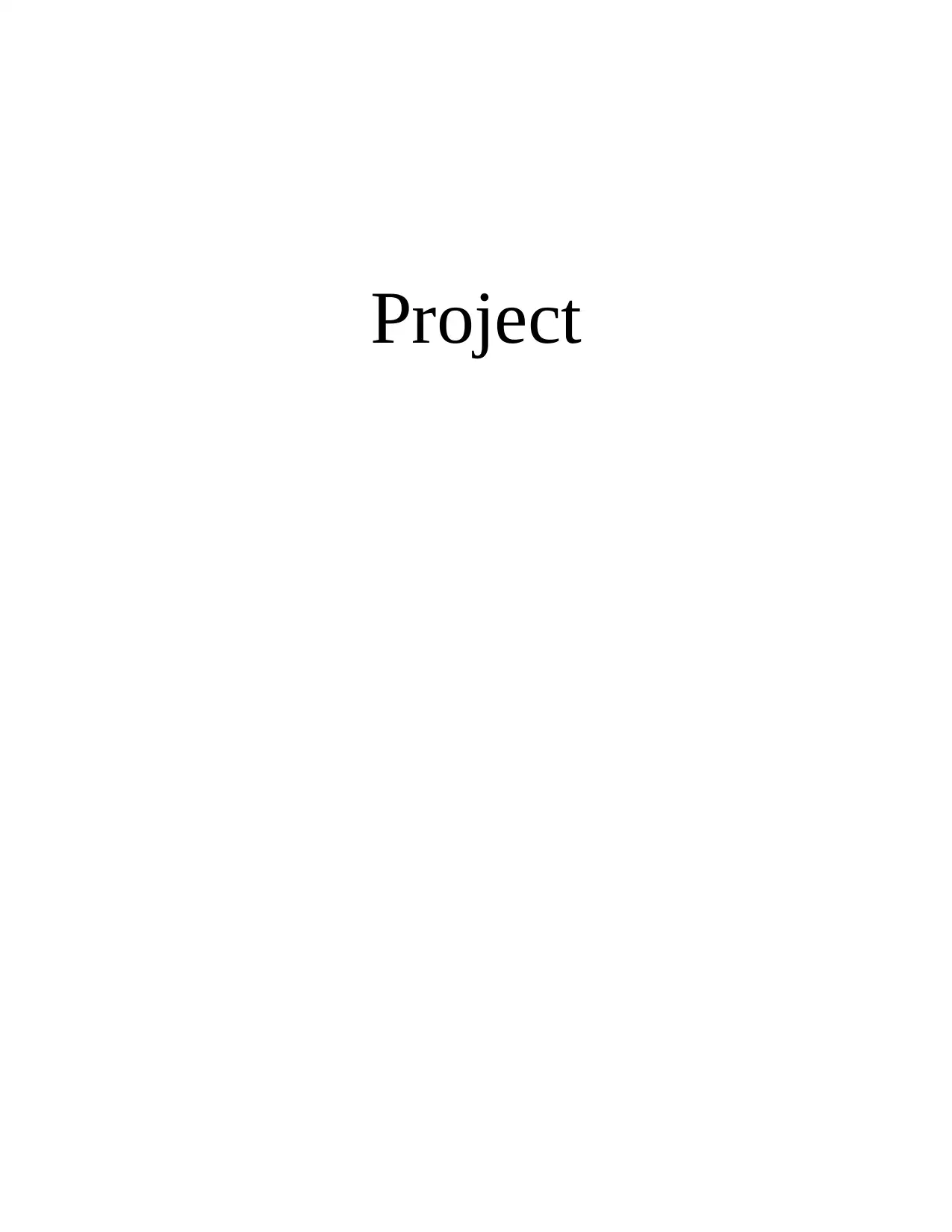
Project
Paraphrase This Document
Need a fresh take? Get an instant paraphrase of this document with our AI Paraphraser
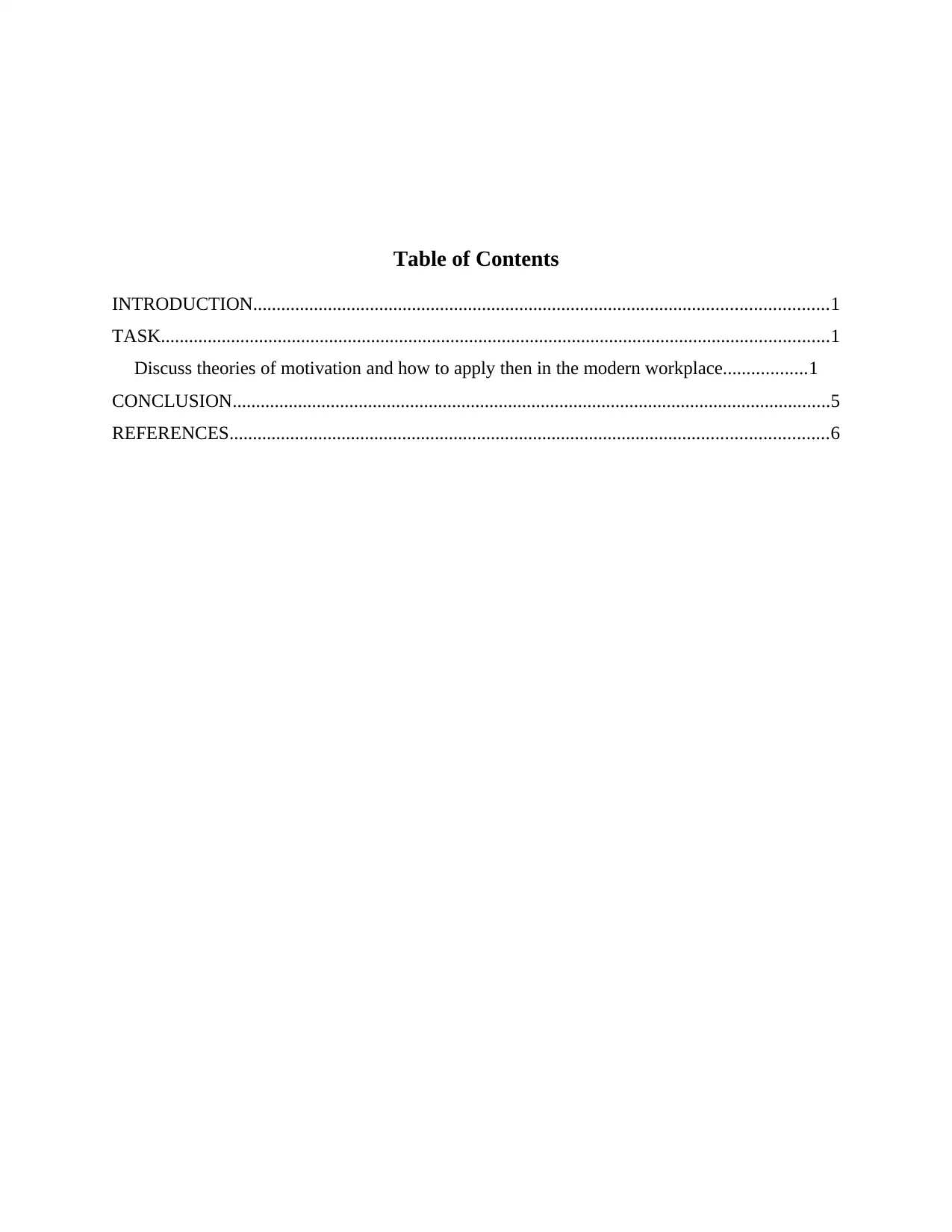
Table of Contents
INTRODUCTION...........................................................................................................................1
TASK...............................................................................................................................................1
Discuss theories of motivation and how to apply then in the modern workplace..................1
CONCLUSION................................................................................................................................5
REFERENCES................................................................................................................................6
INTRODUCTION...........................................................................................................................1
TASK...............................................................................................................................................1
Discuss theories of motivation and how to apply then in the modern workplace..................1
CONCLUSION................................................................................................................................5
REFERENCES................................................................................................................................6
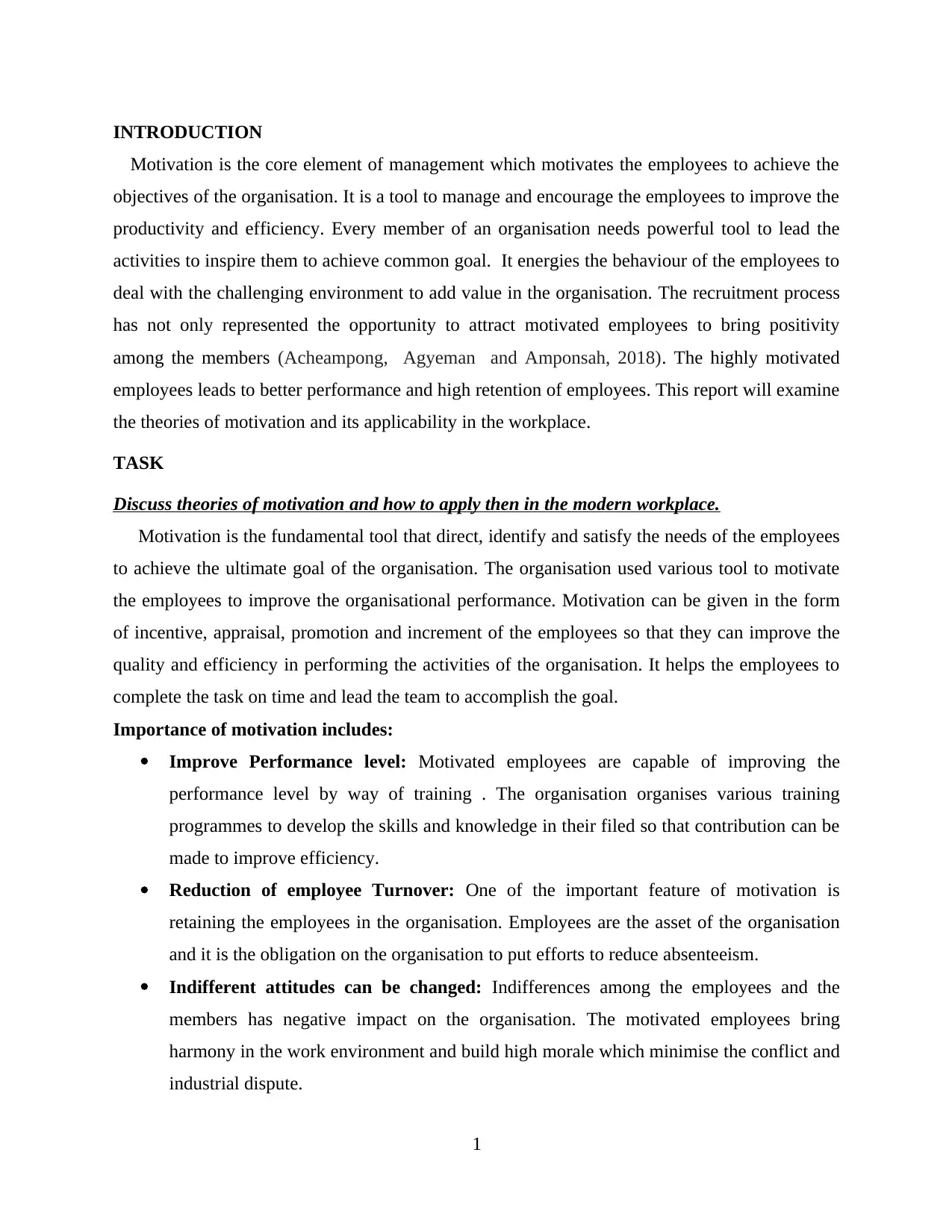
INTRODUCTION
Motivation is the core element of management which motivates the employees to achieve the
objectives of the organisation. It is a tool to manage and encourage the employees to improve the
productivity and efficiency. Every member of an organisation needs powerful tool to lead the
activities to inspire them to achieve common goal. It energies the behaviour of the employees to
deal with the challenging environment to add value in the organisation. The recruitment process
has not only represented the opportunity to attract motivated employees to bring positivity
among the members (Acheampong, Agyeman and Amponsah, 2018). The highly motivated
employees leads to better performance and high retention of employees. This report will examine
the theories of motivation and its applicability in the workplace.
TASK
Discuss theories of motivation and how to apply then in the modern workplace.
Motivation is the fundamental tool that direct, identify and satisfy the needs of the employees
to achieve the ultimate goal of the organisation. The organisation used various tool to motivate
the employees to improve the organisational performance. Motivation can be given in the form
of incentive, appraisal, promotion and increment of the employees so that they can improve the
quality and efficiency in performing the activities of the organisation. It helps the employees to
complete the task on time and lead the team to accomplish the goal.
Importance of motivation includes:
Improve Performance level: Motivated employees are capable of improving the
performance level by way of training . The organisation organises various training
programmes to develop the skills and knowledge in their filed so that contribution can be
made to improve efficiency.
Reduction of employee Turnover: One of the important feature of motivation is
retaining the employees in the organisation. Employees are the asset of the organisation
and it is the obligation on the organisation to put efforts to reduce absenteeism.
Indifferent attitudes can be changed: Indifferences among the employees and the
members has negative impact on the organisation. The motivated employees bring
harmony in the work environment and build high morale which minimise the conflict and
industrial dispute.
1
Motivation is the core element of management which motivates the employees to achieve the
objectives of the organisation. It is a tool to manage and encourage the employees to improve the
productivity and efficiency. Every member of an organisation needs powerful tool to lead the
activities to inspire them to achieve common goal. It energies the behaviour of the employees to
deal with the challenging environment to add value in the organisation. The recruitment process
has not only represented the opportunity to attract motivated employees to bring positivity
among the members (Acheampong, Agyeman and Amponsah, 2018). The highly motivated
employees leads to better performance and high retention of employees. This report will examine
the theories of motivation and its applicability in the workplace.
TASK
Discuss theories of motivation and how to apply then in the modern workplace.
Motivation is the fundamental tool that direct, identify and satisfy the needs of the employees
to achieve the ultimate goal of the organisation. The organisation used various tool to motivate
the employees to improve the organisational performance. Motivation can be given in the form
of incentive, appraisal, promotion and increment of the employees so that they can improve the
quality and efficiency in performing the activities of the organisation. It helps the employees to
complete the task on time and lead the team to accomplish the goal.
Importance of motivation includes:
Improve Performance level: Motivated employees are capable of improving the
performance level by way of training . The organisation organises various training
programmes to develop the skills and knowledge in their filed so that contribution can be
made to improve efficiency.
Reduction of employee Turnover: One of the important feature of motivation is
retaining the employees in the organisation. Employees are the asset of the organisation
and it is the obligation on the organisation to put efforts to reduce absenteeism.
Indifferent attitudes can be changed: Indifferences among the employees and the
members has negative impact on the organisation. The motivated employees bring
harmony in the work environment and build high morale which minimise the conflict and
industrial dispute.
1
You're viewing a preview
Unlock full access by subscribing today!
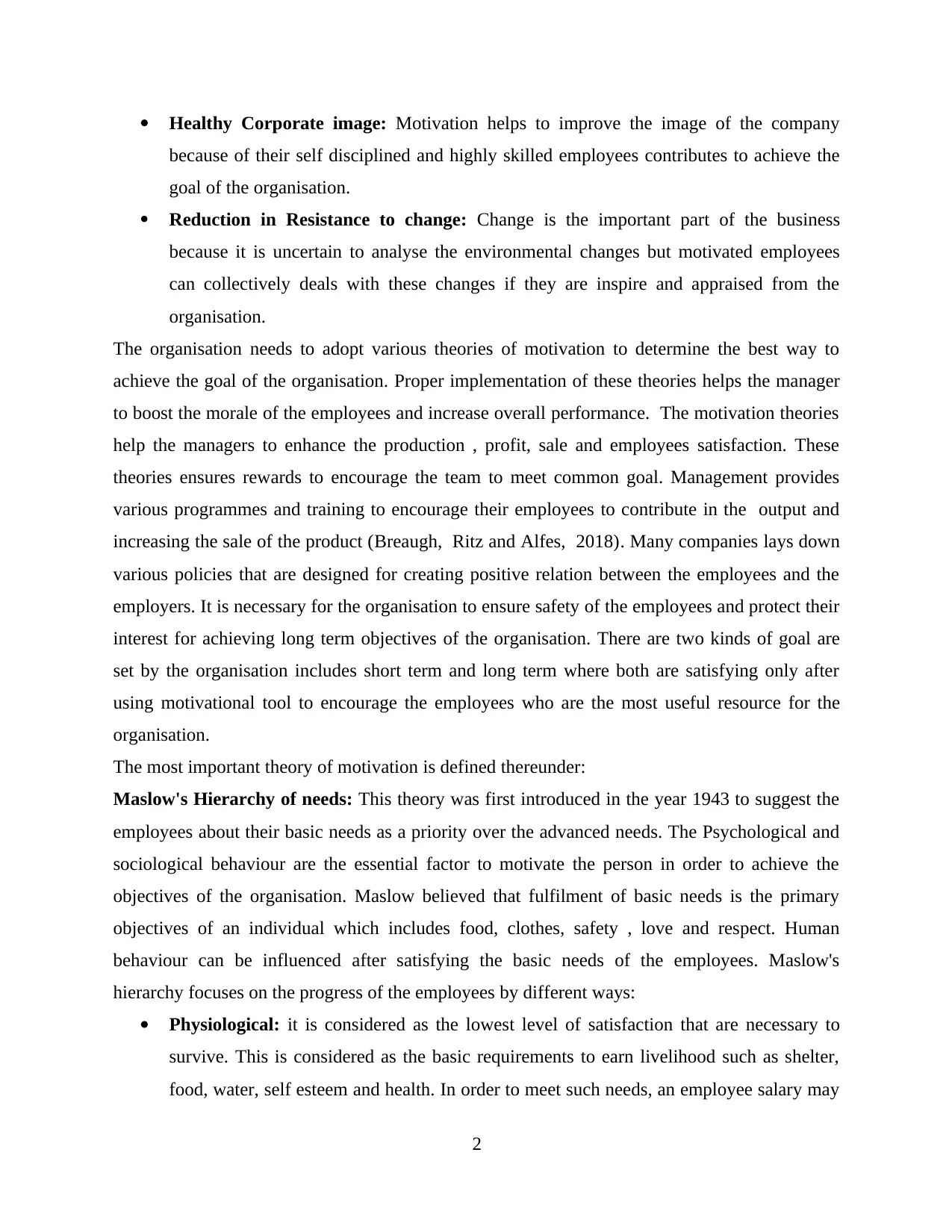
Healthy Corporate image: Motivation helps to improve the image of the company
because of their self disciplined and highly skilled employees contributes to achieve the
goal of the organisation.
Reduction in Resistance to change: Change is the important part of the business
because it is uncertain to analyse the environmental changes but motivated employees
can collectively deals with these changes if they are inspire and appraised from the
organisation.
The organisation needs to adopt various theories of motivation to determine the best way to
achieve the goal of the organisation. Proper implementation of these theories helps the manager
to boost the morale of the employees and increase overall performance. The motivation theories
help the managers to enhance the production , profit, sale and employees satisfaction. These
theories ensures rewards to encourage the team to meet common goal. Management provides
various programmes and training to encourage their employees to contribute in the output and
increasing the sale of the product (Breaugh, Ritz and Alfes, 2018). Many companies lays down
various policies that are designed for creating positive relation between the employees and the
employers. It is necessary for the organisation to ensure safety of the employees and protect their
interest for achieving long term objectives of the organisation. There are two kinds of goal are
set by the organisation includes short term and long term where both are satisfying only after
using motivational tool to encourage the employees who are the most useful resource for the
organisation.
The most important theory of motivation is defined thereunder:
Maslow's Hierarchy of needs: This theory was first introduced in the year 1943 to suggest the
employees about their basic needs as a priority over the advanced needs. The Psychological and
sociological behaviour are the essential factor to motivate the person in order to achieve the
objectives of the organisation. Maslow believed that fulfilment of basic needs is the primary
objectives of an individual which includes food, clothes, safety , love and respect. Human
behaviour can be influenced after satisfying the basic needs of the employees. Maslow's
hierarchy focuses on the progress of the employees by different ways:
Physiological: it is considered as the lowest level of satisfaction that are necessary to
survive. This is considered as the basic requirements to earn livelihood such as shelter,
food, water, self esteem and health. In order to meet such needs, an employee salary may
2
because of their self disciplined and highly skilled employees contributes to achieve the
goal of the organisation.
Reduction in Resistance to change: Change is the important part of the business
because it is uncertain to analyse the environmental changes but motivated employees
can collectively deals with these changes if they are inspire and appraised from the
organisation.
The organisation needs to adopt various theories of motivation to determine the best way to
achieve the goal of the organisation. Proper implementation of these theories helps the manager
to boost the morale of the employees and increase overall performance. The motivation theories
help the managers to enhance the production , profit, sale and employees satisfaction. These
theories ensures rewards to encourage the team to meet common goal. Management provides
various programmes and training to encourage their employees to contribute in the output and
increasing the sale of the product (Breaugh, Ritz and Alfes, 2018). Many companies lays down
various policies that are designed for creating positive relation between the employees and the
employers. It is necessary for the organisation to ensure safety of the employees and protect their
interest for achieving long term objectives of the organisation. There are two kinds of goal are
set by the organisation includes short term and long term where both are satisfying only after
using motivational tool to encourage the employees who are the most useful resource for the
organisation.
The most important theory of motivation is defined thereunder:
Maslow's Hierarchy of needs: This theory was first introduced in the year 1943 to suggest the
employees about their basic needs as a priority over the advanced needs. The Psychological and
sociological behaviour are the essential factor to motivate the person in order to achieve the
objectives of the organisation. Maslow believed that fulfilment of basic needs is the primary
objectives of an individual which includes food, clothes, safety , love and respect. Human
behaviour can be influenced after satisfying the basic needs of the employees. Maslow's
hierarchy focuses on the progress of the employees by different ways:
Physiological: it is considered as the lowest level of satisfaction that are necessary to
survive. This is considered as the basic requirements to earn livelihood such as shelter,
food, water, self esteem and health. In order to meet such needs, an employee salary may
2
Paraphrase This Document
Need a fresh take? Get an instant paraphrase of this document with our AI Paraphraser
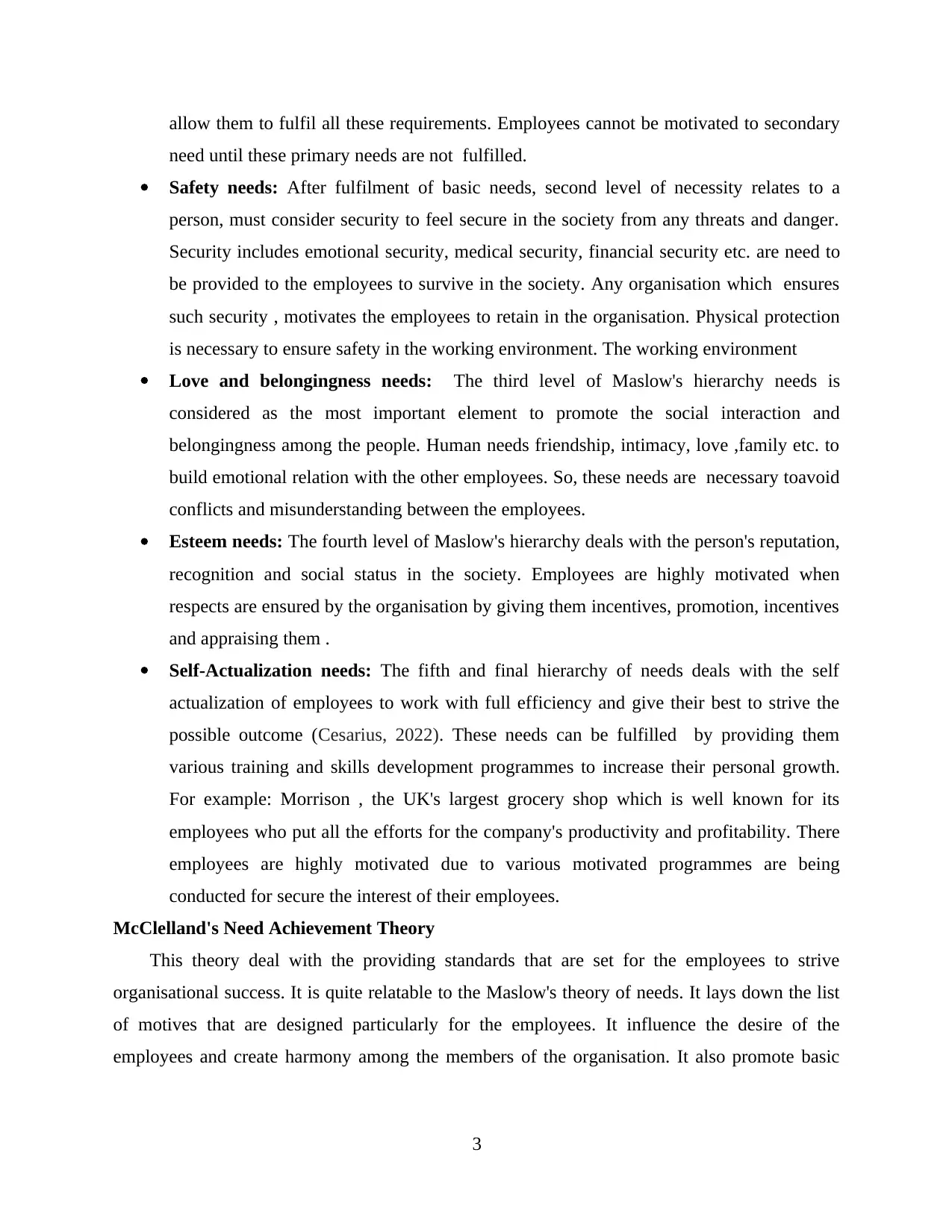
allow them to fulfil all these requirements. Employees cannot be motivated to secondary
need until these primary needs are not fulfilled.
Safety needs: After fulfilment of basic needs, second level of necessity relates to a
person, must consider security to feel secure in the society from any threats and danger.
Security includes emotional security, medical security, financial security etc. are need to
be provided to the employees to survive in the society. Any organisation which ensures
such security , motivates the employees to retain in the organisation. Physical protection
is necessary to ensure safety in the working environment. The working environment
Love and belongingness needs: The third level of Maslow's hierarchy needs is
considered as the most important element to promote the social interaction and
belongingness among the people. Human needs friendship, intimacy, love ,family etc. to
build emotional relation with the other employees. So, these needs are necessary toavoid
conflicts and misunderstanding between the employees.
Esteem needs: The fourth level of Maslow's hierarchy deals with the person's reputation,
recognition and social status in the society. Employees are highly motivated when
respects are ensured by the organisation by giving them incentives, promotion, incentives
and appraising them .
Self-Actualization needs: The fifth and final hierarchy of needs deals with the self
actualization of employees to work with full efficiency and give their best to strive the
possible outcome (Cesarius, 2022). These needs can be fulfilled by providing them
various training and skills development programmes to increase their personal growth.
For example: Morrison , the UK's largest grocery shop which is well known for its
employees who put all the efforts for the company's productivity and profitability. There
employees are highly motivated due to various motivated programmes are being
conducted for secure the interest of their employees.
McClelland's Need Achievement Theory
This theory deal with the providing standards that are set for the employees to strive
organisational success. It is quite relatable to the Maslow's theory of needs. It lays down the list
of motives that are designed particularly for the employees. It influence the desire of the
employees and create harmony among the members of the organisation. It also promote basic
3
need until these primary needs are not fulfilled.
Safety needs: After fulfilment of basic needs, second level of necessity relates to a
person, must consider security to feel secure in the society from any threats and danger.
Security includes emotional security, medical security, financial security etc. are need to
be provided to the employees to survive in the society. Any organisation which ensures
such security , motivates the employees to retain in the organisation. Physical protection
is necessary to ensure safety in the working environment. The working environment
Love and belongingness needs: The third level of Maslow's hierarchy needs is
considered as the most important element to promote the social interaction and
belongingness among the people. Human needs friendship, intimacy, love ,family etc. to
build emotional relation with the other employees. So, these needs are necessary toavoid
conflicts and misunderstanding between the employees.
Esteem needs: The fourth level of Maslow's hierarchy deals with the person's reputation,
recognition and social status in the society. Employees are highly motivated when
respects are ensured by the organisation by giving them incentives, promotion, incentives
and appraising them .
Self-Actualization needs: The fifth and final hierarchy of needs deals with the self
actualization of employees to work with full efficiency and give their best to strive the
possible outcome (Cesarius, 2022). These needs can be fulfilled by providing them
various training and skills development programmes to increase their personal growth.
For example: Morrison , the UK's largest grocery shop which is well known for its
employees who put all the efforts for the company's productivity and profitability. There
employees are highly motivated due to various motivated programmes are being
conducted for secure the interest of their employees.
McClelland's Need Achievement Theory
This theory deal with the providing standards that are set for the employees to strive
organisational success. It is quite relatable to the Maslow's theory of needs. It lays down the list
of motives that are designed particularly for the employees. It influence the desire of the
employees and create harmony among the members of the organisation. It also promote basic
3
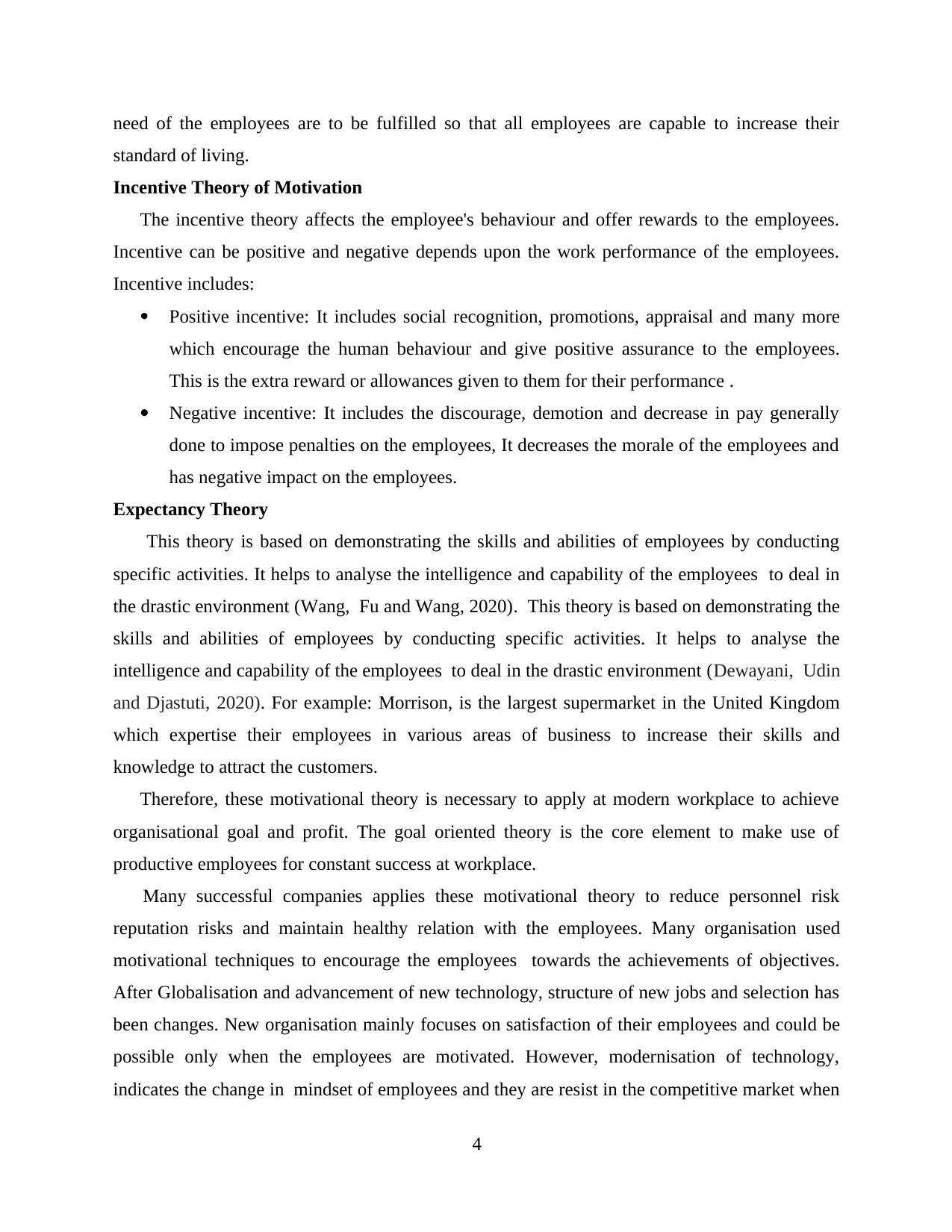
need of the employees are to be fulfilled so that all employees are capable to increase their
standard of living.
Incentive Theory of Motivation
The incentive theory affects the employee's behaviour and offer rewards to the employees.
Incentive can be positive and negative depends upon the work performance of the employees.
Incentive includes:
Positive incentive: It includes social recognition, promotions, appraisal and many more
which encourage the human behaviour and give positive assurance to the employees.
This is the extra reward or allowances given to them for their performance .
Negative incentive: It includes the discourage, demotion and decrease in pay generally
done to impose penalties on the employees, It decreases the morale of the employees and
has negative impact on the employees.
Expectancy Theory
This theory is based on demonstrating the skills and abilities of employees by conducting
specific activities. It helps to analyse the intelligence and capability of the employees to deal in
the drastic environment (Wang, Fu and Wang, 2020). This theory is based on demonstrating the
skills and abilities of employees by conducting specific activities. It helps to analyse the
intelligence and capability of the employees to deal in the drastic environment (Dewayani, Udin
and Djastuti, 2020). For example: Morrison, is the largest supermarket in the United Kingdom
which expertise their employees in various areas of business to increase their skills and
knowledge to attract the customers.
Therefore, these motivational theory is necessary to apply at modern workplace to achieve
organisational goal and profit. The goal oriented theory is the core element to make use of
productive employees for constant success at workplace.
Many successful companies applies these motivational theory to reduce personnel risk
reputation risks and maintain healthy relation with the employees. Many organisation used
motivational techniques to encourage the employees towards the achievements of objectives.
After Globalisation and advancement of new technology, structure of new jobs and selection has
been changes. New organisation mainly focuses on satisfaction of their employees and could be
possible only when the employees are motivated. However, modernisation of technology,
indicates the change in mindset of employees and they are resist in the competitive market when
4
standard of living.
Incentive Theory of Motivation
The incentive theory affects the employee's behaviour and offer rewards to the employees.
Incentive can be positive and negative depends upon the work performance of the employees.
Incentive includes:
Positive incentive: It includes social recognition, promotions, appraisal and many more
which encourage the human behaviour and give positive assurance to the employees.
This is the extra reward or allowances given to them for their performance .
Negative incentive: It includes the discourage, demotion and decrease in pay generally
done to impose penalties on the employees, It decreases the morale of the employees and
has negative impact on the employees.
Expectancy Theory
This theory is based on demonstrating the skills and abilities of employees by conducting
specific activities. It helps to analyse the intelligence and capability of the employees to deal in
the drastic environment (Wang, Fu and Wang, 2020). This theory is based on demonstrating the
skills and abilities of employees by conducting specific activities. It helps to analyse the
intelligence and capability of the employees to deal in the drastic environment (Dewayani, Udin
and Djastuti, 2020). For example: Morrison, is the largest supermarket in the United Kingdom
which expertise their employees in various areas of business to increase their skills and
knowledge to attract the customers.
Therefore, these motivational theory is necessary to apply at modern workplace to achieve
organisational goal and profit. The goal oriented theory is the core element to make use of
productive employees for constant success at workplace.
Many successful companies applies these motivational theory to reduce personnel risk
reputation risks and maintain healthy relation with the employees. Many organisation used
motivational techniques to encourage the employees towards the achievements of objectives.
After Globalisation and advancement of new technology, structure of new jobs and selection has
been changes. New organisation mainly focuses on satisfaction of their employees and could be
possible only when the employees are motivated. However, modernisation of technology,
indicates the change in mindset of employees and they are resist in the competitive market when
4
You're viewing a preview
Unlock full access by subscribing today!
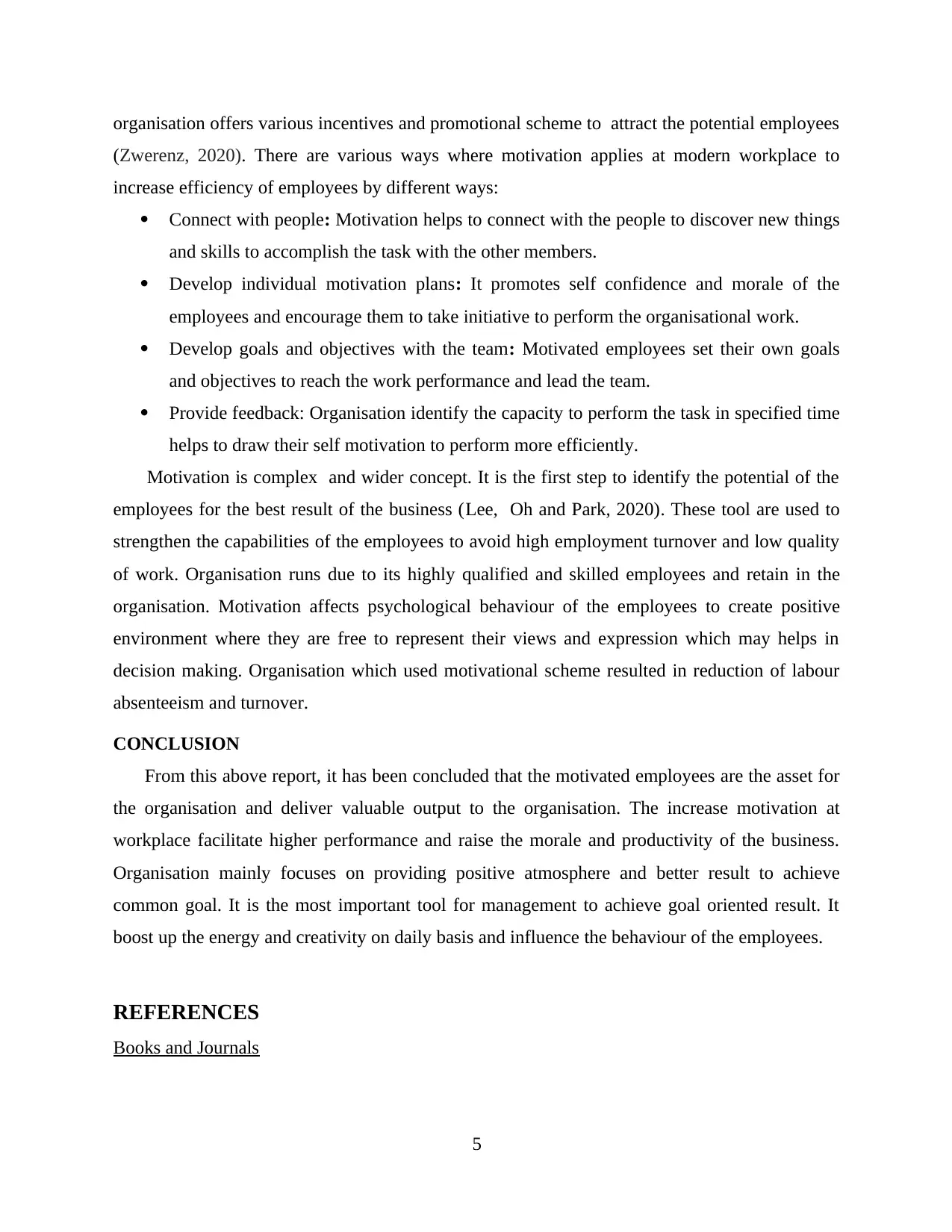
organisation offers various incentives and promotional scheme to attract the potential employees
(Zwerenz, 2020). There are various ways where motivation applies at modern workplace to
increase efficiency of employees by different ways:
Connect with people: Motivation helps to connect with the people to discover new things
and skills to accomplish the task with the other members.
Develop individual motivation plans: It promotes self confidence and morale of the
employees and encourage them to take initiative to perform the organisational work.
Develop goals and objectives with the team: Motivated employees set their own goals
and objectives to reach the work performance and lead the team.
Provide feedback: Organisation identify the capacity to perform the task in specified time
helps to draw their self motivation to perform more efficiently.
Motivation is complex and wider concept. It is the first step to identify the potential of the
employees for the best result of the business (Lee, Oh and Park, 2020). These tool are used to
strengthen the capabilities of the employees to avoid high employment turnover and low quality
of work. Organisation runs due to its highly qualified and skilled employees and retain in the
organisation. Motivation affects psychological behaviour of the employees to create positive
environment where they are free to represent their views and expression which may helps in
decision making. Organisation which used motivational scheme resulted in reduction of labour
absenteeism and turnover.
CONCLUSION
From this above report, it has been concluded that the motivated employees are the asset for
the organisation and deliver valuable output to the organisation. The increase motivation at
workplace facilitate higher performance and raise the morale and productivity of the business.
Organisation mainly focuses on providing positive atmosphere and better result to achieve
common goal. It is the most important tool for management to achieve goal oriented result. It
boost up the energy and creativity on daily basis and influence the behaviour of the employees.
REFERENCES
Books and Journals
5
(Zwerenz, 2020). There are various ways where motivation applies at modern workplace to
increase efficiency of employees by different ways:
Connect with people: Motivation helps to connect with the people to discover new things
and skills to accomplish the task with the other members.
Develop individual motivation plans: It promotes self confidence and morale of the
employees and encourage them to take initiative to perform the organisational work.
Develop goals and objectives with the team: Motivated employees set their own goals
and objectives to reach the work performance and lead the team.
Provide feedback: Organisation identify the capacity to perform the task in specified time
helps to draw their self motivation to perform more efficiently.
Motivation is complex and wider concept. It is the first step to identify the potential of the
employees for the best result of the business (Lee, Oh and Park, 2020). These tool are used to
strengthen the capabilities of the employees to avoid high employment turnover and low quality
of work. Organisation runs due to its highly qualified and skilled employees and retain in the
organisation. Motivation affects psychological behaviour of the employees to create positive
environment where they are free to represent their views and expression which may helps in
decision making. Organisation which used motivational scheme resulted in reduction of labour
absenteeism and turnover.
CONCLUSION
From this above report, it has been concluded that the motivated employees are the asset for
the organisation and deliver valuable output to the organisation. The increase motivation at
workplace facilitate higher performance and raise the morale and productivity of the business.
Organisation mainly focuses on providing positive atmosphere and better result to achieve
common goal. It is the most important tool for management to achieve goal oriented result. It
boost up the energy and creativity on daily basis and influence the behaviour of the employees.
REFERENCES
Books and Journals
5
Paraphrase This Document
Need a fresh take? Get an instant paraphrase of this document with our AI Paraphraser
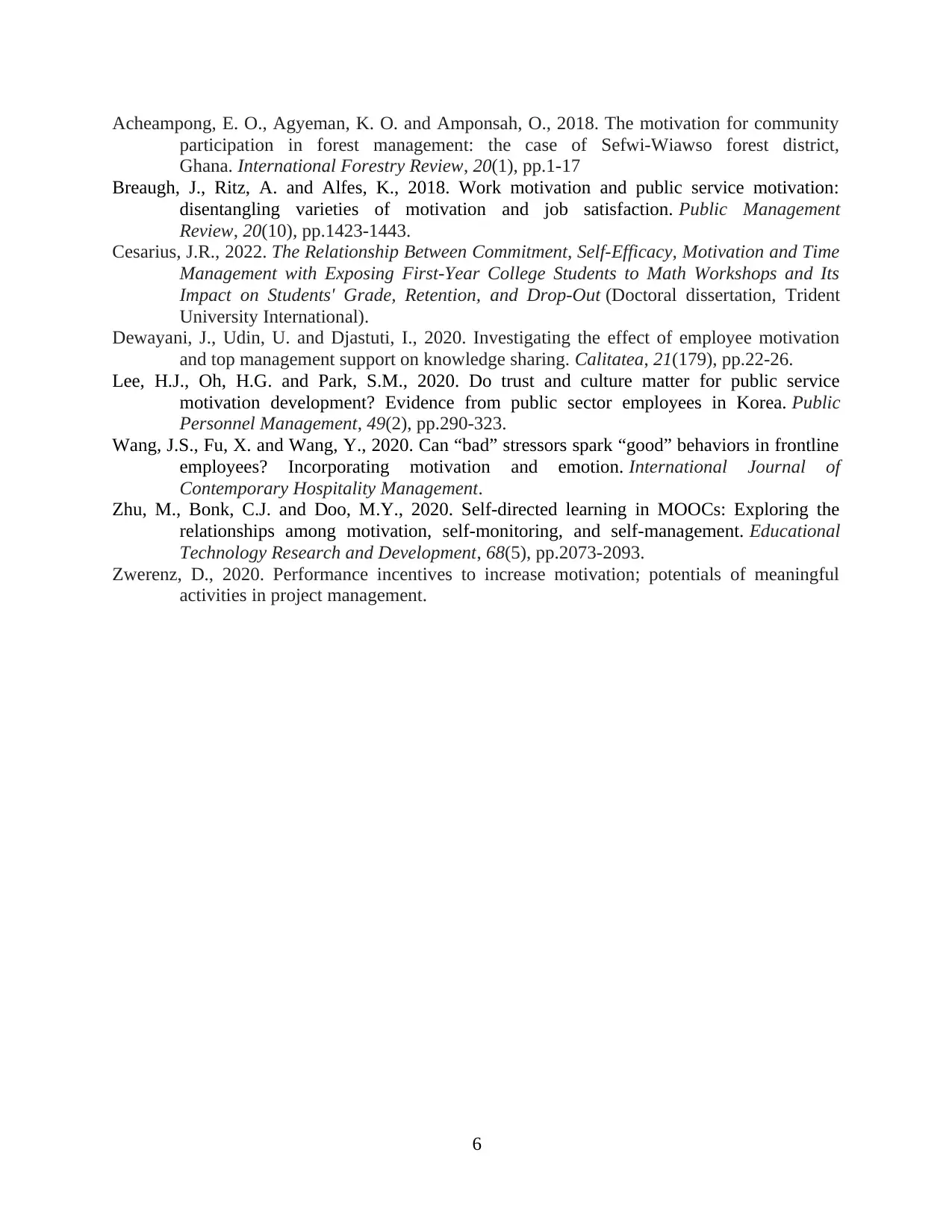
Acheampong, E. O., Agyeman, K. O. and Amponsah, O., 2018. The motivation for community
participation in forest management: the case of Sefwi-Wiawso forest district,
Ghana. International Forestry Review, 20(1), pp.1-17
Breaugh, J., Ritz, A. and Alfes, K., 2018. Work motivation and public service motivation:
disentangling varieties of motivation and job satisfaction. Public Management
Review, 20(10), pp.1423-1443.
Cesarius, J.R., 2022. The Relationship Between Commitment, Self-Efficacy, Motivation and Time
Management with Exposing First-Year College Students to Math Workshops and Its
Impact on Students' Grade, Retention, and Drop-Out (Doctoral dissertation, Trident
University International).
Dewayani, J., Udin, U. and Djastuti, I., 2020. Investigating the effect of employee motivation
and top management support on knowledge sharing. Calitatea, 21(179), pp.22-26.
Lee, H.J., Oh, H.G. and Park, S.M., 2020. Do trust and culture matter for public service
motivation development? Evidence from public sector employees in Korea. Public
Personnel Management, 49(2), pp.290-323.
Wang, J.S., Fu, X. and Wang, Y., 2020. Can “bad” stressors spark “good” behaviors in frontline
employees? Incorporating motivation and emotion. International Journal of
Contemporary Hospitality Management.
Zhu, M., Bonk, C.J. and Doo, M.Y., 2020. Self-directed learning in MOOCs: Exploring the
relationships among motivation, self-monitoring, and self-management. Educational
Technology Research and Development, 68(5), pp.2073-2093.
Zwerenz, D., 2020. Performance incentives to increase motivation; potentials of meaningful
activities in project management.
6
participation in forest management: the case of Sefwi-Wiawso forest district,
Ghana. International Forestry Review, 20(1), pp.1-17
Breaugh, J., Ritz, A. and Alfes, K., 2018. Work motivation and public service motivation:
disentangling varieties of motivation and job satisfaction. Public Management
Review, 20(10), pp.1423-1443.
Cesarius, J.R., 2022. The Relationship Between Commitment, Self-Efficacy, Motivation and Time
Management with Exposing First-Year College Students to Math Workshops and Its
Impact on Students' Grade, Retention, and Drop-Out (Doctoral dissertation, Trident
University International).
Dewayani, J., Udin, U. and Djastuti, I., 2020. Investigating the effect of employee motivation
and top management support on knowledge sharing. Calitatea, 21(179), pp.22-26.
Lee, H.J., Oh, H.G. and Park, S.M., 2020. Do trust and culture matter for public service
motivation development? Evidence from public sector employees in Korea. Public
Personnel Management, 49(2), pp.290-323.
Wang, J.S., Fu, X. and Wang, Y., 2020. Can “bad” stressors spark “good” behaviors in frontline
employees? Incorporating motivation and emotion. International Journal of
Contemporary Hospitality Management.
Zhu, M., Bonk, C.J. and Doo, M.Y., 2020. Self-directed learning in MOOCs: Exploring the
relationships among motivation, self-monitoring, and self-management. Educational
Technology Research and Development, 68(5), pp.2073-2093.
Zwerenz, D., 2020. Performance incentives to increase motivation; potentials of meaningful
activities in project management.
6
1 out of 8
Related Documents
Your All-in-One AI-Powered Toolkit for Academic Success.
+13062052269
info@desklib.com
Available 24*7 on WhatsApp / Email
![[object Object]](/_next/static/media/star-bottom.7253800d.svg)
Unlock your academic potential
© 2024 | Zucol Services PVT LTD | All rights reserved.



